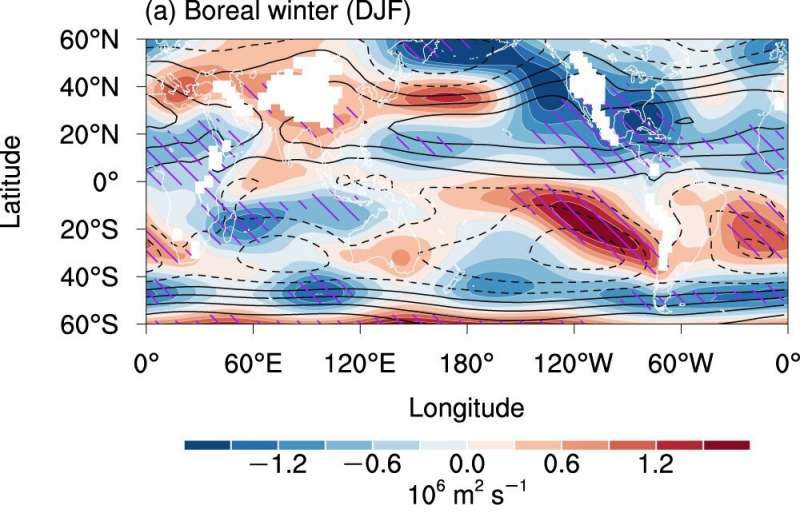Climate models predict weakened subtropical circulation in stable warming scenario
The latest climate models show a weakening of the subtropical circulation under stable greenhouse warming scenario, according to a new study published in Nature Communications.
The low-level subtropical atmospheric circulation, which includes monsoons over land and high-pressure zones over the ocean, plays a pivotal role in shaping the climate, ecosystems, and societies of the surrounding regions.
The study, conducted jointly by researchers from the Institute of Atmospheric Physics of the Chinese Academy of Sciences and Yunnan University, explored various future carbon emission scenarios and uncovered two key drivers behind the changes in the subtropical circulation: The land-sea thermal contrast due to the direct effect of CO2 and surface warming.
These two factors work on distinct time scales. That is, the thermal contrast strengthens the circulation most significantly in the beginning, while the diminishing effect caused by surface warming unfolds gradually.
“The varying contributions of these two factors in different scenarios lead to different results in the model projections. However, in a more stable warming scenario, the subtropical circulation is expected to weaken significantly,” said Prof. Huang Ping, corresponding author of the study.
The researchers used cutting-edge climate models to assess changes in the intensity of the lower-level subtropical atmospheric circulation due to greenhouse warming. The results show that the weakened subtropical circulation implies a reduced monsoon range and increased dryness at the edges of arid regions under a stable warming scenario.
Meanwhile, accurate projections of near-term changes in the subtropical circulation require a thorough consideration of greenhouse gas emission trajectories and the timescales of two key drivers.
“The finding is also helpful in understanding changes in the subtropical circulation in specific regions where large uncertainties remain in the current knowledge,” said Dr. Zhou Shijie, lead author of the study.
More information:
Shijie Zhou et al, Robust changes in global subtropical circulation under greenhouse warming, Nature Communications (2024). DOI: 10.1038/s41467-023-44244-5
Citation:
Climate models predict weakened subtropical circulation in stable warming scenario (2024, January 18)
retrieved 18 January 2024
from https://phys.org/news/2024-01-climate-weakened-subtropical-circulation-stable.html
This document is subject to copyright. Apart from any fair dealing for the purpose of private study or research, no
part may be reproduced without the written permission. The content is provided for information purposes only.

The latest climate models show a weakening of the subtropical circulation under stable greenhouse warming scenario, according to a new study published in Nature Communications.
The low-level subtropical atmospheric circulation, which includes monsoons over land and high-pressure zones over the ocean, plays a pivotal role in shaping the climate, ecosystems, and societies of the surrounding regions.
The study, conducted jointly by researchers from the Institute of Atmospheric Physics of the Chinese Academy of Sciences and Yunnan University, explored various future carbon emission scenarios and uncovered two key drivers behind the changes in the subtropical circulation: The land-sea thermal contrast due to the direct effect of CO2 and surface warming.
These two factors work on distinct time scales. That is, the thermal contrast strengthens the circulation most significantly in the beginning, while the diminishing effect caused by surface warming unfolds gradually.
“The varying contributions of these two factors in different scenarios lead to different results in the model projections. However, in a more stable warming scenario, the subtropical circulation is expected to weaken significantly,” said Prof. Huang Ping, corresponding author of the study.
The researchers used cutting-edge climate models to assess changes in the intensity of the lower-level subtropical atmospheric circulation due to greenhouse warming. The results show that the weakened subtropical circulation implies a reduced monsoon range and increased dryness at the edges of arid regions under a stable warming scenario.
Meanwhile, accurate projections of near-term changes in the subtropical circulation require a thorough consideration of greenhouse gas emission trajectories and the timescales of two key drivers.
“The finding is also helpful in understanding changes in the subtropical circulation in specific regions where large uncertainties remain in the current knowledge,” said Dr. Zhou Shijie, lead author of the study.
More information:
Shijie Zhou et al, Robust changes in global subtropical circulation under greenhouse warming, Nature Communications (2024). DOI: 10.1038/s41467-023-44244-5
Citation:
Climate models predict weakened subtropical circulation in stable warming scenario (2024, January 18)
retrieved 18 January 2024
from https://phys.org/news/2024-01-climate-weakened-subtropical-circulation-stable.html
This document is subject to copyright. Apart from any fair dealing for the purpose of private study or research, no
part may be reproduced without the written permission. The content is provided for information purposes only.
